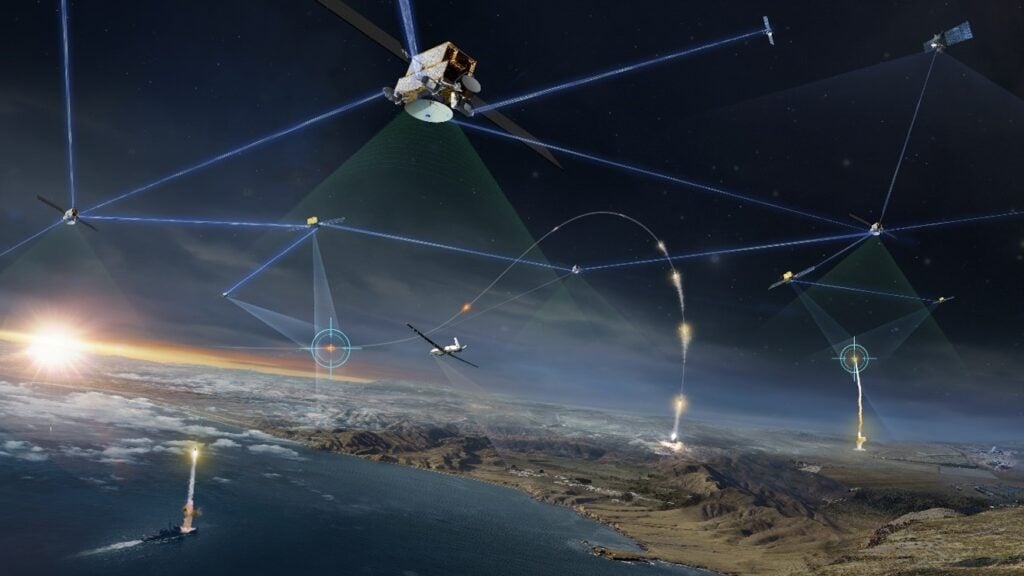
The Space Development Agency will begin launching its Tranche 1 Transport Layer communications mesh network in 2024. (Image: Northrop Grumman)
WASHINGTON: The Pentagon has taken the first steps toward a future “hybrid space architecture” comprising military and commercial satellites in multiple orbits, moving to design a foundational cyber-protected network integration capability — i.e., a hack-proof (or close to it anyway) “internet in space,” officials say.
The hybrid space architecture concept is an outgrowth of Space Force chief Gen. Jay Raymond’s 2020 “Vision for Enterprise Satellite Communications,” first reported by Breaking Defense. And while various experimental efforts to validate the concept of a space-based internet for military users have been ongoing since then, the Defense Department and the Space Force only recently have fully embraced the concept and moved to coordinate a holistic effort to design and develop the capabilities need to substantiate it.
The Space Force’s Space Warfighting Analysis Center (SWAC), DoD’s Defense Innovation Unit (DIU), the Air Force Research Laboratory (AFRL) and the Space Development Agency (SDA) now are cooperating in this potentially revolutionary effort, officials involved told Breaking Defense, which in turn will be a key to enabling Joint All Domain Command and Control (JADC2) for future high-speed, information-centric warfare across the air, land, sea, space and cyber domains. The concept would see concentric circles of satellite communications (SATCOM) networks — highly encrypted military constellations, slightly less secure SATCOM provided by allies, and unclassified commercial constellations.
Recently SWAC has made progress in developing the overarching space data transport “force design” for the concept. Meanwhile, DIU’s project with AFRL, which is designing the glue that will patch the disparate SATCOM networks together, just last week announced concrete steps as well, officials involved said.
And while SDA has already begun to launch a constellation of small satellites in Low Earth Orbit, called the Transport Layer, to allow high speed, low latency, internet-capable data communications, those satellites in effect will become one of the network nodes in the larger network of networks that will connect DoD’s communications satellites in all other orbits as well as selected commercial SATCOM birds, DIU’s Rogan Shimmin told Breaking Defense in a July 7 interview.
“We’ve been in frequent discussions with SDA and also the commercial partners that it is contracting,” Shimmin said. “It’s definitely going to be a very important part of the hybrid space architecture.”
An SDA spokesperson was unable to provide comment by press time.
SWAC Force Design To Inform 2024 Budget
SWAC’s force design is aimed at fleshing out a framework blueprint for future acquisitions, with an eye to informing the fiscal 2024 budget, based on input from DIU, SWAC spokesperson Maj. Sarah Babcock, told Breaking Defense in an email.
“The SWAC partnered with the Defense Innovation Unit to help understand the role in the DoD’s use of commercial services and infrastructure for what has been referred to as the ‘Outernet’,” she said.
Babcock explained that the force design effort is iterative and taking place in increments. So far, the center has completed “initial force designs” for space-to-space and space-to-ground data communications links.
“Initial Force Designs have focused on the large scale topology of the Space-Space and Ground-Space information transport framework to avoid previous traps of building dedicated, non-integrated networks to service specific users. Subsequent force designs are focusing on the particular elements of this integrated architecture, to include narrowband and broadband users,” she said.
Babcock explained that DIU’s role is to help find commercial space communications companies for the Space Force to partner with to create the hybrid architecture and figure out how to best integrate their capabilities and tech.
“DIU’s unique DoD charter to work with commercial organizations across the community provides a partner for identifying commercial investments and their path forward. As communicated by senior leaders, the Space Force wants to leverage commercial investments in space (particularly with space’s integration into 5G architectures) where appropriate,” she explained. “Benefits such as enhanced capacity and performance for information transport can be realized through some of the current and emerging commercial SATCOM and Space [data] Transport companies.”
DIU-AFRL Hybrid Space Architecture Initiative
More details about the effort came to light late last week when the DIU and AFRL’s Space Vehicles Directorate announced a set of four initial contracts under the Hybrid Space Architecture (HSA) program “to provide global, ubiquitous, and secure internet connectivity throughout the space domain for commercial, civil, and military users, including international allies and partners.”
Shimmin, who is managing the HSA program, said that the new contracts — Aalyria, Anduril, Atlas, and Enveil — are being funded by AFRL under a previous effort called the “hybrid gateway satellite.” Under the effort, the contractors will contribute payloads to a “free-flying satellite that’s going to test a lot of these different communications architectures,” he said.
An AFRL spokesperson told Breaking Defense in a July 12 email that the effort falls under the purview of the lab’s Small Satellite Portfolio team, but that it is too early to comment beyond the information in the DIU press release.
The lab began experiments in 2019 to understand how commercial space-based internet services, such as SpaceX’s Starlink, might be used to enhance all domain operations under a project called Defense Experimentation Using the Commercial Space Internet (DEUCSI) and nicknamed Global Lightening. The project was a part of then-Air Force acquisition czar Will Roper’s signature effort to create an “Internet of Military Things” via the service’s Advanced Battle Management System initiative.
And AFRL’s Space Vehicles Directorate on April 12 opened its new Rapid Architecture Prototyping and Integration Development, or RAPID, laboratory specifically aimed at research on small satellites and the future hybrid space architecture.
“Hybrid space architecture encompasses large and small satellites, and the RAPID lab will expand on AFRL’s development of small satellites, which have proven to be valuable in furthering the nation’s space priorities,” said Col. Jon Luminati, who leads the directorate’s Integrated Experiments and Evaluation Division, said in the April 22 press release provided to Breaking Defense.
Shimmin said the DIU is funding “a large line of effort” in parallel, with “three awards pending hopefully within the next month” to internet cloud providers. The contracts will be focused on how to design the new mixed architecture to make sure different levels of data security, from highly classified to unclassified, can be maintained. For example, he said, contractors will be looking at “network orchestration modules” to automate interactions across different types of satellite nodes.
“The intent is that this software defined network will be generic enough that we can integrate in any other satellite networks, and that it can include a set of gateway satellites” to provide inter-satellite and space-to-ground links, as well as to platforms on the air and at sea, Shimmin said.
Four Critical Capabilities
DIU last October issued its first solicitations under the HSA initiative. The effort, according to the July 7 release, has four technology thrusts:
Multi-path communications. “A robust, secure software defined network (SDN) will be necessary to integrate diverse telecom systems across Low Earth Orbit, Medium Earth Orbit, Geostationary Orbit, and cislunar space. Currently, there is limited communication between these telecom systems; this SDN will have to maintain careful network orchestration to predict link availability, manage radio frequency and optical beam pointing, and mitigate traffic congestion.”
Multi-source data fusion. “There is already a vast array of sensors available via space assets and the terrestrial internet. Common data standards and interfaces will be necessary to fuse this data for efficient storage and rapid search. In addition, to best leverage the array of sensors while minimizing operator training costs, common command and control interfaces to manage data collection will be necessary.”
Cloud-based analytics. “The ubiquitous availability of proliferated sensor data opens up boundless new opportunities for artificial intelligence and machine learning applications, across commercial, government, and military uses. The new paradigm of cloud computing allows raw data to be processed into actionable intelligence anywhere there is available compute capacity, from large server farms to orbiting (or lunar) edge compute hardware, to distributed processing across a network of small devices.”
Variable trust protocol. “Distributed communications provides network resilience because the system can accommodate individually lost links and nodes. We must ensure that we do not introduce vulnerabilities through the increased access points. Industry gold standards must be observed, including link and end-to-end quantum-resistant encryption, dependable cryptographic key distribution, zero-trust continuous authentication, and data integrity ledgers. Due to the broad variety of participating networks, each link and each node will be dynamically assigned a trust score based on observed behavior within the architecture. The traffic can then be routed over preferred links based on sensitivity and timeliness.”
Shimmin said that while DIU’s normal deadline for project completion is 24 months, because many of the software tools involved in the first set of HSA contracts are commercially available, it might be possible to test some on orbit in less than a year.
“It’s time for the internet to move off-planet,” Shimmin summed up in DIU’s press release. “Just as we couldn’t imagine all the uses of the internet in the early days of ARPANET, the scope of the HSA is immense and revolutionary.”






















